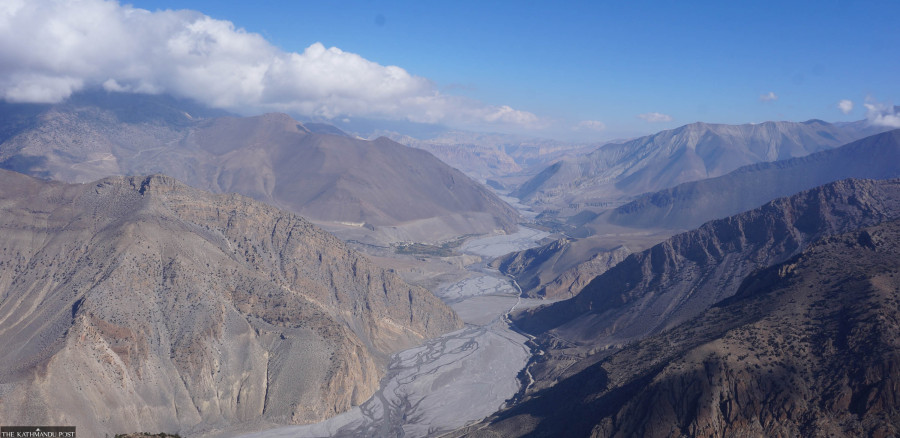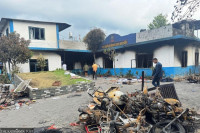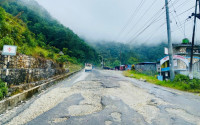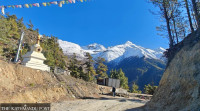Gandaki Province
Siltation in Kaligandaki river affects settlements and arable lands in Mustang
Erosion of the banks and siltation gain momentum during the monsoon, which can lead to floods and inundation.
Ghanshyam Khadka
Decades of siltation on the Kaligandaki riverbed and the simultaneous erosion of its riverbanks have put the settlements along the river in Mustang at risk of floods and inundation.
“Kaligandaki in Mustang is an aggrading river, as it collects sediment and deposits it in the river, leading to increase in its bed height. The swift tributary streams that merge into the river bring debris while flowing through the higher reaches. When the debris reaches downstream, it settles down and piles up over the years,” said Jhalak Mohan Ojha, the chief at the Drinking Water, Water Resources and Irrigation Sub-Division Office in Mustang.
The Kaligandaki turns shallow and slow as it meanders south through the hills and mountains and loses its ability to wash the debris away.
According to Ojha, the erosion and siltation of the river gain momentum during the monsoon season which can lead to floods and inundation. “Climate change can also have an impact on the rivers. An integrated conservation programme is the need of the hour to lessen the impacts of climate change on mountains, streams and rivers,” he said.
Every year, the increased flow of water in the river during the monsoon season inundates the surrounding settlements.
“The river overflows and floodwaters enter our villages every year,” said Raju Gauchan, a local resident of Sauru in Ward No. 3 of Thasang. “The monsoon season is harsh on us. We can’t cross the river in the absence of a bridge. We have to walk for a day to reach Kobang across the river.”
Both human settlements and arable lands are at high risk of floods and inundation during the monsoon season but no concrete steps have been taken to mitigate the risks.
According to Rishi Baral, chief at the Jomsom Annapurna Conservation Area Project, the Kaligandaki river in Mustang does not have permanent embankments and the riverbed settlements receive little protection from the floodwaters from the temporary ones.
“Setting up temporary embankments is not the solution. The government should build permanent embankments so as to avoid disasters in the future,” said Baral. “It is time to conduct an environmental impact assessment of the Kaligandaki area to protect the settlements along the riverbanks.”
Villages in Jomsom, Tukche, Kobang, Sauru and Dhampu among others in Mustang stand to be affected by the Kaligandaki river if measures are not taken to mitigate the risk of floods in the area.
“Tukche, Kowang, Chiwang, Sauru, Marpha, Syang, Jomsom, Puthang, Kagbeni and Chhukchhan are at risk of floods, as the riverbed is gaining height due to siltation,” said Niraj Thakali of Jomsom, the district headquarters of Mustang.
Several fast flowing streams like Lete, Sete, Laikyu, Thapa, Chimang, Boksi, Tama, Tukche, Marpha, Syang, Thini, Panda, Jhong, Narsing and Sangta, among others, empty into the Kaligandaki river. These streams originate from Nilgiri South and North, Dhawalagiri and Tukche peaks.




 10.12°C Kathmandu
10.12°C Kathmandu.jpg)








%20(1).jpg&w=300&height=200)

